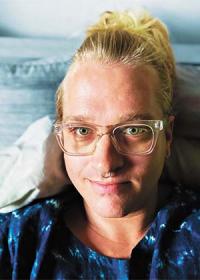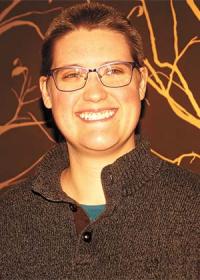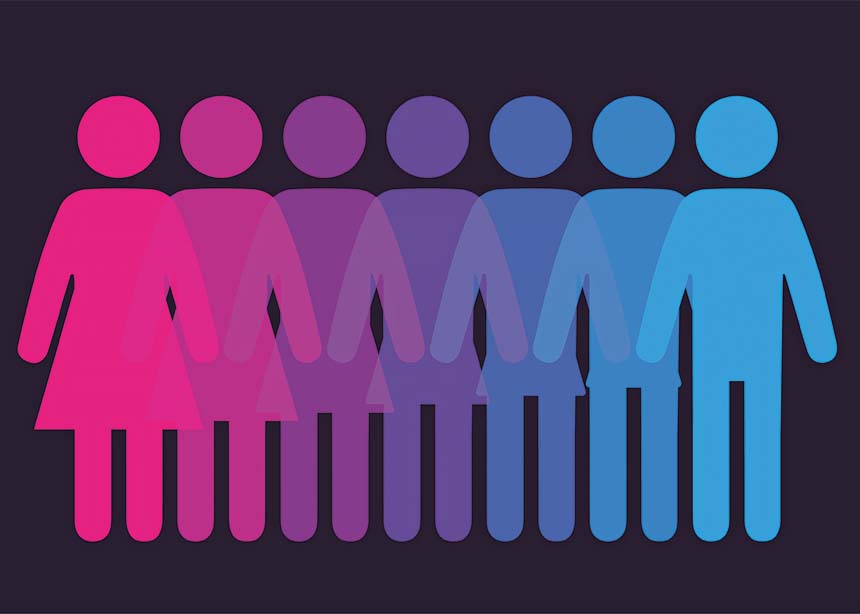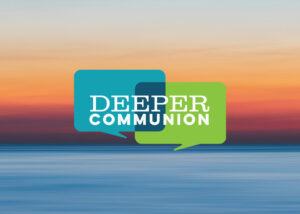Although some Mennonite churches in Canada have wrestled with whether to accept LGBTQ+ people in their congregations, the conversation around queer issues is rapidly expanding in the public sphere. Gender identity is one topic that has been gaining popularity in the last several years, yet the experiences of transgender and gender-diverse Mennonites remain relatively unexplored in the Mennonite church. What are the trans members of the Mennonite family encountering in the church and the broader world?
The reality is that living as a trans person is difficult in most of the world.

Twenty-seven-year-old Hillary Siemens (who uses the pronouns she/her) lives in Winnipeg and attends Home Street Mennonite Church. As a trans woman who works from home as a call centre representative, she is misgendered daily because of her low voice. “It’s not a great feeling to hear ‘thank you sir’ every day. It’s very hard to face,” she says, acknowledging this is hard to solve unless she changes her voice.
Siemens came out to herself in May 2019 after a long process. Like many other trans folks, Siemens didn’t know she was trans when she was younger. She jokes that it took her a while to clue in—one night, a month after one of her friends sent her some trans information, the realization and the tears hit her. Everything was starting to make sense. In this society structured in binaries, it’s difficult for people to explore their understanding and expression of gender. Especially when, like trans people, they don’t often see themselves represented in media.
Twenty-two-year-old Alex (they/them) identifies as genderqueer, a label they place under the transgender umbrella. They do not identify as either male or female—rather, they fall completely outside of the gender binary. When Alex (a pseudonym) came out to their mom, she was accepting but didn’t ask many questions or do her own research. She has rarely broached the topic since. “It’s been a year-and-a-half, and she still slips up with misgendering me,” they said.
Alex, a university student, grew up attending a Mennonite church and worked at a Mennonite camp in high school. In their experience, the church tends to avoid tough topics: “If it’s something they’re uncomfortable with, whether it’s because they disagree with it or just don’t know much about it . . . they just won’t address it.”
Joy and exclusion
A popular narrative is that trans people are plagued with a lifetime of struggle and hatred for their bodies. While true for some, many gender-nonconforming people regularly experience gender euphoria—moments of joy and pride when they are able to express who they really are—says Josephine Kroeker (she/her), 39. She is a stay-at-home mom who runs a micro-bakery out of her kitchen in Saskatoon. She is a trans woman whose journey to realize her identity launched from one such positive moment.

She was out dancing with her partner and friends on Pride weekend in 2019 and tied her button-down shirt into a crop top, which accentuated her bust, a part of herself about which she had always been self-conscious. But when she looked at a photo of that night, she felt excited instead of ashamed.
Most of Kroeker’s physical transition so far has happened during the pandemic. “For a lot of people going through something similar, this has been a gift,” she says. Limited public events and more time at home mean Kroeker has been able to explore her gender presentation, experimenting with clothing and makeup without having to face discrimination in public.
Kroeker says it’s hard to read the Confession of Faith in a Mennonite Perspective and see people like her excluded from the church in its pages. “It makes for some aggravating reading,” she says. She knows many congregations don’t adhere to all the Confession’s pillars, but she believes that the church’s foundational document and Mennonite Church Canada policies still exclude queer people.
Positive examples of church-trans relationships
Kroeker’s relationship with her own congregation, Wildwood Mennonite Church in Saskatoon, is a positive one. She is an active member of the affirming congregation, preaching and leading worship in services, and that didn’t change after she transitioned.

When 26-year-old Ellis Hamm (they/them) came out to their community at Hope Mennonite Church in Winnipeg, the pastor asked if they wanted to have a naming ceremony at church to acknowledge the new name they had chosen as part of their transition.
Hamm, who is studying education at university, identifies broadly as nonbinary and trans. “What is cool about Hope is how ready people are to find new ways to celebrate and welcome you (or re-welcome you),” they say. When the congregation moved to a new building that had no gender-neutral washrooms, they immediately designated several of them as gender-neutral. This was significant for Hamm because it indicated Hope Mennonite was a safe space for them to come out.
One of the first people Siemens came out to was a person from her church. Since then, the pandemic has prevented her from attending many worship services in person, which has also limited the chances of hearing herself being misgendered by fellow congregants. But so far she has experienced only support from the pastors and fellow congregants she’s encountered.
But not all experiences are positive
These stories tell of relatively good experiences within the church. But that is certainly not the case for many trans Mennonites, who have been deeply hurt by the church. Many do not feel safe to come out or speak about their experiences. They have been told to live in secret or leave the church because the environment has become too harmful. Still others may not know they’re trans because condemnation has prevented them from imagining the possibility.
Living as a trans person is also dangerous for many. In 2020, the Human Rights Campaign documented 44 violent deaths of transgender people in the United States, many of whom were Black and Latina trans women. Statistics Canada reported in 2018 that transgender and gender-diverse people in Canada were more than twice as likely as cisgender people to have experienced unwanted sexual behaviours in public places that made them feel unsafe.
“There is a lot of violence against trans people, especially trans people that are visible and don’t fit traditional white beauty standards,” Siemens says.
One in three trans youth in Canada attempted suicide in 2015, according to the Centre for Suicide Prevention. The Trevor Project reported that 52 percent of all transgender and nonbinary young people in the United States seriously contemplated suicide in 2020.
“My church is the one place where I have been consistently safe,” says Rowan Wiebe (they/them), 27, of Calgary. “If every queer kid growing up in a church today had that place, the suicide rate would tank in this country for LGBT youth.”
In 2019, the Trevor Project reported that LGBTQ+ youth who have at least one supportive adult in their life were 40 percent less likely to report a suicide attempt that year.
“Just one person can make a huge difference in someone’s life,” Hamm says, emphasizing how important a role pastors and congregations have.
Ways churches can be supportive
In 2021, Canadian Mennonite officially updated its policy to accept the use of singular they/them pronouns, after previously declining to use the terminology and receiving complaints and calls for change from readers. This joins a vocabulary shift that is increasingly being adopted by mainstream culture.
“If you need a trans voice on anything, you can find it, because trans people have had to advocate for everything they’ve ever needed,” Hamm says. “What we need now is cis people talking to people like them and saying, “Look there are people that are different than us and they are also human beings.”
Stock your church library with books by trans authors and sing worship songs written by queer composers, host trans speakers and have pastors say their pronouns at the pulpit, Wiebe suggests. “I think churches in general, a lot of it’s the basics they’re missing,” they say, mentioning creating gender-neutral washrooms, wearing pronoun pins, officiating gay weddings and baptizing queer people.

Wiebe grew up volunteering at the Mennonite Central Committee thrift shop with their grandparents and attending their grandparents’ Mennonite Brethren church, as well as a Christian Missionary Alliance church. Wiebe, who identifies as non-binary, studied political science and leads a queer advocacy group. They were assigned female at birth, and growing up they felt a lot of pressure to dress and act in ways that fit the traditional expectations of what a girl should be. But neither male nor female was an identity they fit.
None of Wiebe’s family are practising Mennonites anymore, and Wiebe now attends an Evangelical Covenant church in Calgary. The congregation helped Wiebe choose a new name, and all seven pastors use Wiebe’s correct name and pronouns.
‘God talk’ in a trans world
When Wiebe was 18, they stopped attending church for a while because they couldn’t find an affirming congregation. Instead, they went to a park every Sunday morning and read Scripture, spending time with God. “I don’t think I ever stopped believing in God, I just stopped believing in other people,” they said.
Others interviewed expressed similar sentiments: Even if they struggled with the church, they maintained faith and relationship with God. For many, exploring and developing a rich queer theology has bolstered their sense of belonging in God’s family.
“God created us in God’s image. God is a creator; thus we have become creators,” Hamm says. “Trans people are such a cool, tangible example of human beings being creators. . . . God didn’t create you wrong, God created you, and you are trans, and you will continue God’s act of creation in your life.”
While some Christians draw on biblical binaries, like Adam and Eve, to explain their stance against queer identities and relationships, Wiebe points to the many nonbinary elements also present in the creation story that queer theologians write about. God made day and night, but God also made dusk and dawn. God made earth and sea, but also swamps and beaches, the birds of the sky and also ostriches. “God has always loved ambiguity, God has always created more than we can imagine or put in boxes easily,” Wiebe says.
Hamm adds, “Often trans people understand the complexities of God in ways that other people don’t get, because we talk about God being more than one thing at a time and holding these different identities.” As a Trinity, God is simultaneously a communion of three. God is known through a multitude of metaphors and is yet beyond them all. Genderqueer people especially have the gift of understanding multiple identities, Hamm says.
Alex recently started going to queer theology nights at the United church they currently attend. They studied scriptural references and the linguistic roots of words. They discussed the nonbinary identities of Jesus: divine and human, dead and alive, part of history yet beyond time, male but also described as Wisdom, characterized as female.
“It’s so cool to see queerness actually referenced in Scripture. It’s so exciting,” Alex says, animatedly. “This is the first time I’ve ever had that be a topic of discussion.” Alex thinks that, if more people were exposed to queer theology, it would help validate trans and queer Christian identity, a reality that has existed for centuries.
Even if congregations don’t think they have any trans members, that doesn’t mean they don’t, and it’s not a reason to avoid the topic, Alex says. It’s also why people can’t give up on the church.
“For some queer people it’s easy to toss the whole church away and just forget about it, if that’s been a source of pain for them,” they say. “But there’s never not going to be some kid [in church] who’s growing up who realizes they’re trans. There’s never not going to be somebody going through that.”
Some key terms
- LGBTQ+: An acronym for lesbian, gay, bisexual, transgender, queer/questioning, plus all the other sexual orientations, sexes and genders that aren’t included in these few letters.
- Sex: A categorization based on the appearance of the genitalia at birth.
- Gender identity: A person’s innermost concept of self as male, female, a blend of both or neither. How individuals perceive themselves and what they call themselves. A person’s gender identity can be the same or different from their sex assigned at birth.
- Transgender (or trans): A term for people who identify with a gender other than the sex they were assigned at birth.
- Cisgender (or cis): A term for people whose gender identity aligns with the sex they were assigned at birth.
- Non-binary: A person who doesn’t identify exclusively as a man or a woman. Non-binary people may identify as both male and female, somewhere in between or neither, falling completely outside these categories. While many also identify as transgender, not all non-binary people do.
- Queer: A term people often use to express a spectrum of identities and orientations that are counter to the mainstream. Queer is often used as a catch-all to include many people, including those who do not identify as exclusively straight and folks who have non-binary or gender-expansive identities. This term was previously used as a slur, but it has been reclaimed by many parts of the LGBTQ+ community.
- Transitioning: Processes that some transgender people undergo in order to live more fully as their true gender. This typically includes social transition, such as changing name and pronouns; medical transition, like hormone therapy or gender-affirming surgeries; and legal transition, including changing legal name and gender on government identity documents. Trans people may choose to undergo some, all, or none of these processes.
—Compiled by Nicolien Klassen-Wiebe
For discussion
1. What have been your struggles in accepting the body you have? How did you learn about gender identity as a child? Do you see gender as something that is either male or female, or do you see it as more of a spectrum?
2. How have you seen gender diversity being expressed in your community? Are there gender-nonconforming people in your congregation? Are they welcomed in your community or viewed with uncertainty? Why might some people feel uncomfortable around those who are gender diverse?
3. According to the Trevor Project, many transgender and nonbinary young people contemplate suicide. Why do you think this is the case? Why would they feel less safe than other young people?
4. “Using appropriate pronouns is one way of signalling an affirming space for gender-diverse people,” writes Nicolien Klassen-Wiebe. Where have you seen this vocabulary shift to using singular they/them pronouns? How long do you think it will take our society to be comfortable with this change?
5. How welcoming is your congregation for people who do not fit the traditional norms? How could your congregation be more supportive to gender-diverse people?
—By Barb Draper









Leave a Reply
You must be logged in to post a comment.